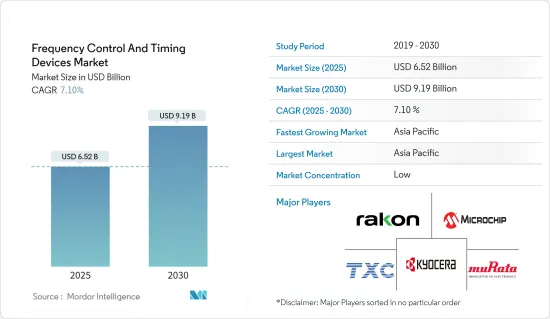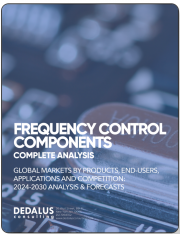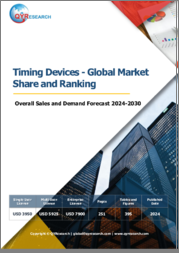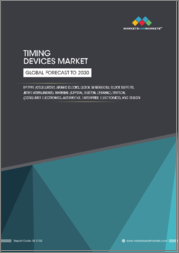
|
시장보고서
상품코드
1692459
세계의 주파수 제어 및 타이밍 장치 시장 : 점유율 분석, 산업 동향 및 통계, 성장 예측(2025-2030년)Frequency Control And Timing Devices - Market Share Analysis, Industry Trends & Statistics, Growth Forecasts (2025 - 2030) |
||||||
세계의 주파수 제어 및 타이밍 장치 시장 규모는 2025년에 65억 2,000만 달러로 추정되며, 예측 기간 중(2025-2030년) CAGR 7.1%로 확대되어, 2030년에는 91억 9,000만 달러에 도달할 것으로 예측됩니다.

주파수 제어 및 타이밍 장치(FCTD)는 다양한 전자 시스템에서 타이밍 신호를 생성, 제어, 동기화하는 전자 부품입니다. 타이밍 장치의 원리를 수정 진동자, MEMS, 세라믹 공진기에 적용하여 안정적인 주파수 발진을 가능하게 합니다. 이 타이밍 장치는 Zigbee, Bluetooth 등의 무선 용도(스마트폰 등), 자동차, 의료기기 등의 장치의 정확한 동작에 도움이 됩니다.
인쇄 회로 기판(PCB)의 인기가 급상승하고 있는 것이 주파수 제어 및 타이밍 장치 시장의 성장을 가속하는 주요 요인이 되고 있습니다. 이 복잡성은 적절한 동작을 보장하기 위해 정확한 타이밍과 신호 무결성을 필요로 합니다.
디지털 전환을 가속화하는 산업계의 대처가 시장의 성장을 뒷받침하고 있습니다.이것에는 「인더스트리 4.0」컨셉으로의 이행이 포함되어, 산업용 셋업에 있어서의 자동화, 로봇 공학, AI나 IIoT등의 첨단 솔루션의 채용 확대를 규정하고 있습니다.
세계의 5G 기술의 채용 확대가 주파수 제어 및 타이밍 장치의 성장을 크게 뒷받침하고 있습니다.
주파수 제어 및 타이밍 장치 시장은 전자 산업에서 중요한 부문이며 다양한 용도에 필수적인 구성 요소를 제공합니다.
경제 성장, 인플레이션, 정부지출 우선순위, 세계무역, 지정학적역학 등 일부 거시경제 동향은 각국의 방위예산에 영향을 미칩니다.
주파수 제어 및 타이밍 장치 시장 동향
건설 부문의 성장이 가구 제품 수요를 밀어
- 가전, 주파수 제어, 타이밍 장치는 스마트폰이나 태블릿, 웨어러블 장치, 스마트 홈 장치, 텔레비전이나 셋톱 박스, 게임기, 디지털 카메라 등에 응용되고 있습니다.
- 소비자용 전자기기는 보다 소형화, 성능을 최적화하고 에너지 효율을 높이고 있습니다. 이러한 변화는 수정 진동자 등의 내부 부품에 직접 영향을 미칩니다. 수정 진동자의 신뢰성은 장치의 성능을 향상시키고 배터리의 긴 수명화로 이어지는 에너지를 절약하는 데 도움이 됩니다.
- 스마트폰의 보급이 시장의 성장에 중요한 역할을 담당하고 있습니다.
- Ericsson의 모빌리티 보고서에 따르면, 5G의 보급이 계속 호조로, 2023년에는 세계에서 약 6억건의 신규 계약이 추가됨에 따라, 일부 시장에서 경제적 과제나 지정학적 불안이 계속되고 있음에도 불구하고, 고성능 접속에 대한 수요가 탄력적입니다. Ericsson에 따르면 세계의 5G 계약 수는 2029년에는 53억을 넘어 전체 모바일 계약 수의 58%를 차지할 것으로 예측되고 있습니다.
아시아태평양이 큰 시장 점유율을 차지할 전망
- 아시아태평양은 특히 인도와 중국 등 주요 경제권에서 스마트폰 소비자 수 증가, 데이터센터, 5G 기술 채용 증가, 산업 자동화 등으로 급속한 성장이 예상되고 있습니다.
- 중국의 스마트폰 산업은 Huawei, Apple, Samsung, Xiaomi, Lenovo 등의 주요 기업으로 구성되어 있습니다.
- 아시아태평양에서는 한국이 주파수 제어 및 타이밍 장치의 중요한 시장으로 돌출한 지위를 차지하고 있습니다.
- 게다가 시장 경쟁의 격화가 전자기기의 증산으로 연결되어 수정 진동자 수요를 더욱 밀어 올리고 있습니다.
- 이 지역의 자동차 산업은 생산 대수가 크게 늘어나고 있으며, 이것이 시장 성장의 원동력이 되고 있습니다. 주파수 제어 및 타이밍 장치는 정확한 타이밍과 동기를 제공하기 위해 안전 시스템에서 사용됩니다.
주파수 제어 및 타이밍 장치 산업 개요
주파수 제어 및 타이밍 장치 시장은 세분화되어 경쟁이 치열합니다. 시장은 매우 단편화되어 있으며, 주요 기업은 제품 혁신, 신제품 출시, 파트너십, 제휴, M&A 등의 전략을 채용하고 있습니다.
2024년4월 - 첨단 전자 부품 제조업체 인 Kyocera Avx는 "Kyocera Avx Components Corporation(Erie)"의 명칭으로, 고품질 및 저노이즈의 수정 진동자 주파수 제어 제품의 새로운 제조 및 설계 센터를 발표했습니다.
2024년 2월 - Rakon은 MWC Barcelona 2024에서 최신 무선 네트워크 및 IT 및 통신 데이터센터용 초기 확장 홀드오버 솔루션을 전시했습니다. 주파수 에러 교환 처리와 에이징 보상을 통합하여 네트워크 싱크로나이저 평가 보드상의 시스템의 전류 동기 능력을 향상시켜 홀드오버 성능을 향상시킵니다.
기타 혜택:
- 엑셀 형식 시장 예측(ME) 시트
- 3개월간의 애널리스트 서포트
목차
제1장 서론
- 조사의 전제조건과 시장 정의
- 조사 범위
제2장 조사 방법
제3장 주요 요약
제4장 시장 인사이트
- 시장 개요
- 업계의 매력도 - Porter's Five Forces 분석
- 구매자의 협상력
- 공급기업의 협상력
- 신규 참가업체의 위협
- 대체품의 위협
- 경쟁 기업간 경쟁 관계
- 밸류체인 분석
- 시장의 거시경제 동향 분석
제5장 시장 역학
- 시장 성장 촉진요인
- 세계의 5G의 보급 확대
- 첨단 자동차 용도에서 수요 증가
- 시장의 과제
- 개발 비용의 높이
제6장 시장 세분화
- 유형별
- 수정 진동자
- 발진기
- 온도 보상형 수정 발진기(TCXO)
- 전압 제어 크리스탈 발진기(VCXO)
- 오븐 제어 수정 발진기(OCXO)
- MEMS 발진기
- 기타 발진기
- 공진기
- 최종 사용자 산업별
- 자동차
- 컴퓨터 및 주변기기
- 통신, 서버 및 데이터 스토리지
- 가전
- 산업용
- 군사 및 항공우주
- 기타 최종 사용자 산업
- 지역별
- 북미
- 유럽
- 아시아
- 호주 및 뉴질랜드
- 라틴아메리카
- 중동 및 아프리카
제7장 경쟁 구도
- 기업 프로파일
- Murata Manufacturing Co. Ltd
- Kyocera Corporation
- Rakon Limited
- Microchip Technology Inc.
- TXC Corporation
- Seiko Epson Corporation
- Daishinku Corporation
- Hosonic Technology(Group) Co. Ltd
- Nihon Dempa Kogyo Co. Ltd
- SiTime Corporation
- SIWARD Crystal Technology Co. Ltd.
- Texas Instruments Inc.
- NXP Semiconductors
- Abracon LLC
제8장 투자 분석
제9장 시장 기회와 앞으로의 동향
JHS 25.05.07The Frequency Control And Timing Devices Market size is estimated at USD 6.52 billion in 2025, and is expected to reach USD 9.19 billion by 2030, at a CAGR of 7.1% during the forecast period (2025-2030).

Frequency control and timing devices (FCTD) are electronic components that generate, control, and synchronize timing signals in various electronic systems. They are crucial in ensuring accurate timing, synchronization, and coordination of operations within these systems. Applying the principles of timing devices to quartz crystals, MEMS, and ceramic resonators makes it possible to generate oscillations with stable frequencies. These timing devices help to ensure the precise operation of devices in Zigbee, Bluetooth, and other wireless applications (such as smartphones), automobiles, and medical equipment.
The surging popularity of printed circuit boards (PCBs) is a key driver for the growth of the frequency control and timing devices market. Modern PCBs are becoming increasingly complex, with higher component density and functionality packed into smaller spaces. This complexity necessitates precise timing and signal integrity to ensure proper operation. FCTDs are important in managing these complexities by providing stable reference frequencies and signal integrity.
Industrial organizations' efforts to accelerate digital transformation drive the market's growth. This includes shifting to the "industry 4.0" concept, which governs a higher adoption of automation, robotics, and advanced solutions such as AI and IIoT in industrial setups.
The growing adoption of 5G technology worldwide significantly drives the growth of frequency control and timing devices. 5G networks utilize higher frequency bands, including millimeter-wave frequencies (24GHz and above), which require exact frequency control devices to maintain signal integrity and performance. With the expanded bandwidth capabilities of 5G, precise timing is essential to handle large amounts of data being transmitted and received, necessitating advanced oscillators and clock generators.
The frequency control and timing devices market is a critical segment within the electronics industry, providing essential components for various applications. However, the high costs associated with developing and producing frequency control and timing devices are challenging the market's growth.
Several macroeconomic trends, like economic growth, inflation, government spending priorities, global trade, and geopolitical dynamics, affect the defense budgets of various countries. According to the US Congressional Budget Office, defense spending in the United States is predicted to increase yearly until 2033. Defense outlays in the United States amounted to USD 746 billion in 2023, and the forecast predicts an increase to USD 1.1 trillion in 2033.
Frequency Control And Timing Devices Market Trends
Growth in the Construction Sector Boosting the Demand for Furniture Products
- Consumer electronics, frequency control, and timing devices find applications in smartphones and tablets, wearable devices, smart home devices, television and set-top boxes, gaming consoles, and digital cameras.
- Consumer electronics are becoming more compact, optimized for performance, and energy-efficient. These changes directly impact internal components such as crystals. Crystals are utilized in various products, including wearables, smartphones, PCs, gaming consoles, and TVs, to provide crucial timing signals for accurate data processing. Their reliability improves device performance and helps conserve energy, leading to extended battery life. This precision plays a vital role in establishing user confidence, driving the increasing popularity of wearables and other sophisticated electronics.
- The increase in smartphone adoption has played a key role in the market's growth. Crystal oscillators are essential in providing accurate timing signals for smartphones, tablets, and other electronic gadgets. As technology progresses and electronic components become smaller, crystal oscillators have become vital in ensuring optimal performance standards.
- According to Ericsson's mobility report, the continued strong uptake of 5G, with around 600 million new subscriptions added globally during 2023, shows that demand for high-performance connectivity remains resilient despite ongoing economic challenges and geopolitical unrest in some markets. As per Ericsson, the global 5G subscriptions are forecast to exceed 5.3 billion in 2029, making up 58% of all mobile subscriptions. It is also projected that North America and GCC will have the highest 5G penetration in 2029 at 92%, followed by Western Europe at 85%.
Asia-Pacific is Expected to Hold Significant Market Share
- The Asia-Pacific region is expected to witness rapid growth due to the rising number of smartphone consumers, data centers, rising adoption of 5G technology, industrial automation, etc., particularly in major economies like India and China. The recent advancements in crystal oscillators play a crucial role in enhancing overall efficiency and greatly improving accuracy in various applications.
- The Chinese smartphone industry is comprised of major players such as Huawei, Apple, Samsung, Xiaomi, and Lenovo. Most smartphone manufacturing facilities in China are in Guangdong Province, Beijing, Tianjin, and Shanghai. They are expected to sell significantly more smartphones in China in the coming years. This leads to the demand for crystal oscillators to improve the use of WiFi and Bluetooth combo chipsets in smartphone applications.
- In the Asia-Pacific region, South Korea holds a prominent position as a crucial market for frequency control and timing devices. This is primarily due to the extensive utilization of this technology by various industries in the country, such as consumer electronics, industrial robots, telecommunication equipment, and 5G services. These industries are recognized as major proponents of crystal oscillators.
- In addition, the escalating competition in the market has led to an increased production of electronic devices, further fueling the demand for crystal oscillators. Furthermore, the growing popularity of VCOs in the production of electronic music devices has also contributed significantly to this growth.
- The automotive sector across the region has witnessed significant growth in production, which fuels the market growth. Frequency control and timing devices are used in safety systems to provide accurate timing and synchronization. These systems include airbag deployment, anti-lock braking, electronic stability control, and collision avoidance systems.
Frequency Control And Timing Devices Industry Overview
The frequency control and timing devices market is fragmented and highly competitive. The market appears to be highly fragmented, with significant players adopting strategies like product innovation, new product launches, partnerships, collaborations, and mergers and acquisitions. Some of the major players in the market are Murata Manufacturing Co. Ltd, Kyocera Corporation, Rakon Limited, Microchip Technology Inc., and TXC Corporation.
April 2024 - Kyocera Avx, a manufacturer of advanced electronic components, unveiled a new manufacturing and design center for high-quality, low-noise quartz crystal frequency control products under the name Kyocera Avx Components Corporation (Erie). The newly established production facility is expected to manufacture over 1.2 million patented and unparalleled low-power OCXO (oven-controlled crystal oscillators) and a range of TCXO (temperature-computed crystal oscillators) and VCXO (voltage-computed crystal oscillators).
February 2024 - Rakon displays its initial extended holdover solution for modern radio networks and telecommunications data centers at MWC Barcelona 2024. The Error Exchange OCXO (MercuryXE2) is a version of Rakon's recently launched Mercury compact IC-OCXO. It improves the system's current synchronization abilities on a network synchronizer evaluation board by incorporating frequency error exchange processing and aging compensation, thereby increasing the holdover performance.
Additional Benefits:
- The market estimate (ME) sheet in Excel format
- 3 months of analyst support
TABLE OF CONTENTS
1 INTRODUCTION
- 1.1 Study Assumptions and Market Definition
- 1.2 Scope of the Study
2 RESEARCH METHODOLOGY
3 EXECUTIVE SUMMARY
4 MARKET INSIGHTS
- 4.1 Market Overview
- 4.2 Industry Attractiveness - Porter's Five Forces Analysis
- 4.2.1 Bargaining Power of Buyers
- 4.2.2 Bargaining Power of Suppliers
- 4.2.3 Threat of New Entrants
- 4.2.4 Threat of Substitutes
- 4.2.5 Intensity of Competitive Rivalry
- 4.3 Value Chain Analysis
- 4.4 Analysis of Macroeconomic Trends on the Market
5 MARKET DYNAMICS
- 5.1 Market Drivers
- 5.1.1 Growing Adoption of 5G Across the World
- 5.1.2 Rising Demand from Advanced Automotive Applications
- 5.2 Market Challenges
- 5.2.1 High Cost of Development
6 MARKET SEGMENTATION
- 6.1 By Type
- 6.1.1 Crystals
- 6.1.2 Oscillators
- 6.1.2.1 Temperature Compensated Crystal Oscillator (TCXO)
- 6.1.2.2 Voltage-controlled Crystal Oscillator (VCXO)
- 6.1.2.3 Oven-controlled Crystal Oscillator (OCXO)
- 6.1.2.4 MEMS Oscillator
- 6.1.2.5 Other Types of Oscillators
- 6.1.3 Resonators
- 6.2 By End-user Industry
- 6.2.1 Automotive
- 6.2.2 Computer and Peripherals
- 6.2.3 Communications/Server/Data Storage
- 6.2.4 Consumer Electronics
- 6.2.5 Industrial
- 6.2.6 Military and Aerospace
- 6.2.7 Other End-user Industries
- 6.3 By Geography
- 6.3.1 North America
- 6.3.2 Europe
- 6.3.3 Asia
- 6.3.4 Australia and New Zealand
- 6.3.5 Latin America
- 6.3.6 Middle East and Africa
7 COMPETITIVE LANDSCAPE
- 7.1 Company Profiles
- 7.1.1 Murata Manufacturing Co. Ltd
- 7.1.2 Kyocera Corporation
- 7.1.3 Rakon Limited
- 7.1.4 Microchip Technology Inc.
- 7.1.5 TXC Corporation
- 7.1.6 Seiko Epson Corporation
- 7.1.7 Daishinku Corporation
- 7.1.8 Hosonic Technology (Group) Co. Ltd
- 7.1.9 Nihon Dempa Kogyo Co. Ltd
- 7.1.10 SiTime Corporation
- 7.1.11 SIWARD Crystal Technology Co. Ltd.
- 7.1.12 Texas Instruments Inc.
- 7.1.13 NXP Semiconductors
- 7.1.14 Abracon LLC



















